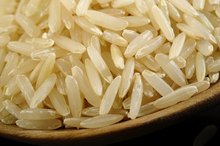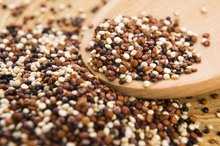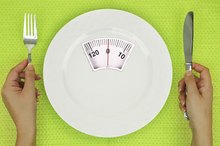Do Whole Grains Cause You to Gain Weight?
While grains might seem high in calories, they're actually a healthy addition to a weight-loss diet. They’re packed with vitamins, minerals, antioxidants and fiber, which are lost when the grain is processed to produce white flour and white rice. Whole grains and their fiber are actually associated with lower body weight rather than weight gain. They will cause weight gain, however, if you exceed your daily calorie goal, so make sure to measure your portions to avoid overeating.
Calorie Control for Weight Management
You'll need a daily calorie goal in order to discern whether whole grains are causing weight gain. The first step is to determine the number of calories required to maintain your current weight by using the online calculator provided by the Baylor College of Medicine.
If you're at a healthy weight, eating the calories indicated by the calculator will help you maintain your weight. If you want to lose or gain weight, then subtract or add 500 calories to your daily maintenance calories. This amount results in a loss or gain of 1 pound weekly. How much you'll be able to eat depends on the overall size of your diet, but you should be able to fit whole grains into even restrictive weight-loss diets.
Calories in Whole Grains
How to Convert BMI to Pounds
Learn More
Whole grains are moderately high in calories, but if you incorporate them into your daily calorie budget, they won't make you gain weight. A 1-cup serving of cooked teff has 255 calories, brown rice contains 218 and the same portion of whole-wheat pasta has 174 calories. Two slices of whole-wheat bread, a large whole-wheat pita and 1 cup of cooked oatmeal are in the range of 161 to 168 calories.
Pay attention to portion size when you're eating whole grains to avoid overeating. If you’ve never measured cooked pasta, chances are your plate holds more than 1 cup. And keep in mind that any toppings -- whether that's avocado on your toast or Bolognese sauce on your pasta -- add calories as well.
Carbs in Whole Grains and Blood Sugar
Whole grains have less of an effect on your blood sugar compared to refined grains, making the former beneficial for weight loss. When you eat fast-digesting carbs like white flour, you'll experience blood sugar spikes and crashes, which can make you feel hungry. The glycemic index measures how much a food impacts your blood sugar. Foods with a glycemic score of 55 have a low GI -- and a less pronounced effect on blood sugar -- while a score of 70 counts as high-GI and causes blood sugar spikes.
Most whole grains have a low GI score, but there are some exceptions. Whole-grain bread and wheat tortillas are low-glycemic foods. A bowl of regular oatmeal has a glycemic index score of 55, but if you pile on sugar, honey or maple syrup, the added sugar will tip the scale into the moderate glycemic range. Instant oats are whole grains, but their processing means they have a glycemic index of 83, so they significantly spike blood sugar.
Whole Grains Help Prevent Weight Gain
How to Lose 45 Pounds in 2 Months
Learn More
A few studies have linked whole grains to better weight management. A review published in July 2012 in the Journal of Nutrition reported that people who ate three to five servings of whole grains daily gained less weight over eight to 13 years than those who never or rarely ate whole grains. Whole grains prevent weight gain by reducing appetite -- thanks to their high fiber content -- and helping you consume fewer calories, reported Advances in Nutrition in September 2012.
Eating whole grains may even fight the accumulation of abdominal fat, especially if you start replacing refined grains in your diet with whole grains. People who consume three servings of whole grains daily have a smaller waist circumference and 10 percent less visceral fat stored around organs in the abdomen than those who eat less than one serving daily, according to studies cited in Advances in Nutrition. Researchers also found that consuming four or more daily servings of refined grains counteracts the benefits of whole grains.
Intake Recommendations and Considerations
Adults should consume 6 to 8 ounces of grains daily, with at least half of the total consisting of whole grains, recommends the U.S. Department of Agriculture. Examples of a 1-ounce serving include one slice of bread, half of an English muffin, 1 cup of ready-to-eat cereal and 1/2 cup of cooked rice, pasta or hot cereal. When you buy whole-grain products, make sure the first item in the list of ingredients is a whole grain. Oats and brown rice are always whole grains; in other grain products, look for the word "whole," as in "whole-wheat" or "100 percent whole grain." If the label simply says "wheat" or "multiple grains," it’s not a whole-grain product.
If you've been following a low-carb diet, adding more whole grains to your meal plan might cause water weight gain by replenishing your body's carbohydrate stores. Your body stores glycogen -- the type of carbohydrate used for energy -- along with water, so boosting your glycogen levels will also increase your water stores. This weight gain doesn't mean you've added any fat to your frame, however.
Related Articles
References
- HealthAliciousNess: Top 10 Foods Highest in Calories
- Harvard Medical School: Glycemic Index and Glycemic Load for 100+ Foods
- Colorado State University: Physiologic Effects of Insulin
- California State University, San Bernardino: Carbohydrate
- American Council on Exercise: Why Do I Seem to Gain Weight When I Start to Train for an Endurance Race Like a Half Marathon?
- Journal of Nutrition: Greater Whole-Grain Intake Is Associated With Lower Risk of Type 2 Diabetes, Cardiovascular Disease, and Weight Gain
- Advances in Nutrition: The Role of Whole Grains in Body Weight Regulation
Resources
Writer Bio
Sandi Busch received a Bachelor of Arts in psychology, then pursued training in nursing and nutrition. She taught families to plan and prepare special diets, worked as a therapeutic support specialist, and now writes about her favorite topics – nutrition, food, families and parenting – for hospitals and trade magazines.









